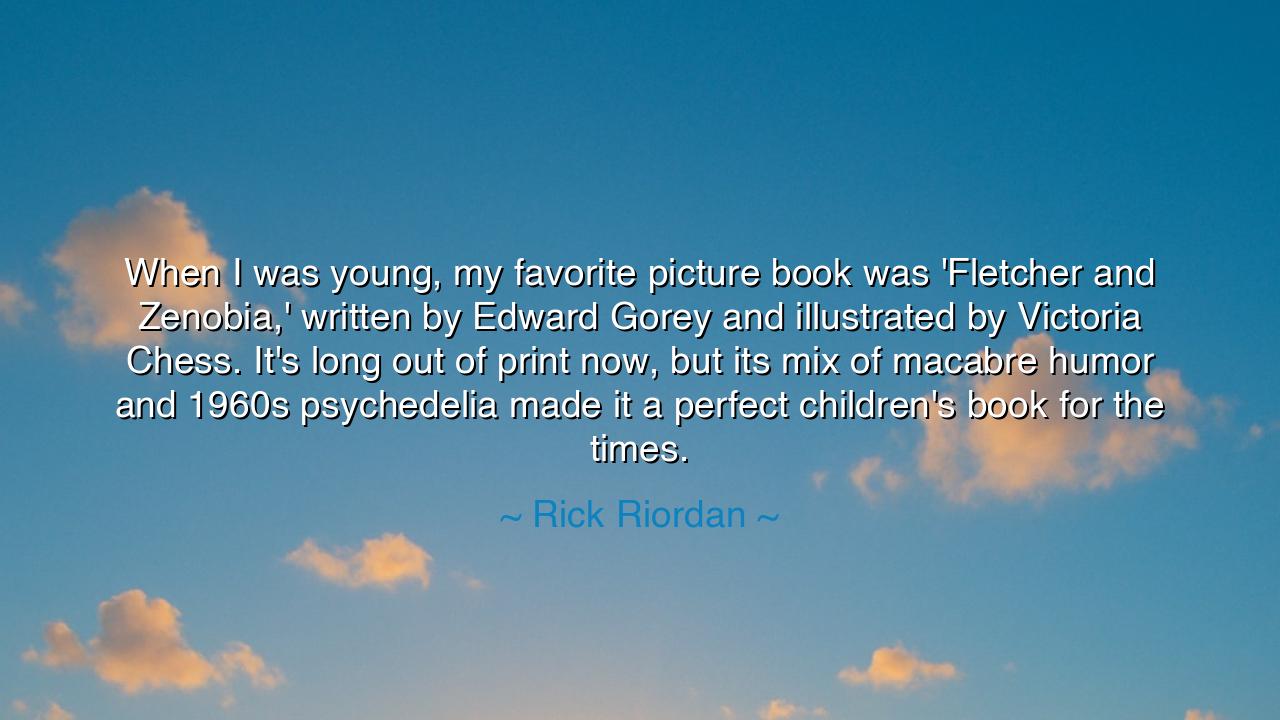
When I was young, my favorite picture book was 'Fletcher and
When I was young, my favorite picture book was 'Fletcher and Zenobia,' written by Edward Gorey and illustrated by Victoria Chess. It's long out of print now, but its mix of macabre humor and 1960s psychedelia made it a perfect children's book for the times.






In the thoughtful and nostalgic words of Rick Riordan, we hear a reflection not merely on a childhood memory, but on the strange alchemy through which imagination is born: “When I was young, my favorite picture book was ‘Fletcher and Zenobia,’ written by Edward Gorey and illustrated by Victoria Chess. It’s long out of print now, but its mix of macabre humor and 1960s psychedelia made it a perfect children’s book for the times.” Beneath the surface of this simple remembrance lies a truth profound and enduring — that the stories we encounter in youth do not merely entertain us; they shape our perception of the world, and in their shadows and colors, we find the beginnings of who we are.
The origin of this quote rests in Riordan’s own journey from reader to storyteller — from a child captivated by the curious blend of darkness and whimsy to the creator of worlds where myth, magic, and humanity intertwine. By recalling “Fletcher and Zenobia,” a collaboration between the eccentric Edward Gorey and the imaginative Victoria Chess, Riordan pays homage to the creative forces that molded his imagination. This book, with its peculiar marriage of macabre humor and psychedelic wonder, reflected the restless spirit of the 1960s — a time when the world was questioning tradition, experimenting with perception, and inviting even children to explore life’s strangeness through art. In it, Riordan found not fear in the macabre, but freedom — the understanding that darkness, too, can be a place of wonder.
The ancients understood this union of shadow and light. In the myths of ancient Greece, even the most heroic tales were tinged with tragedy, and even the darkest stories carried the spark of wisdom. The tale of Persephone, who journeys into the underworld and returns each spring, teaches that life itself depends on the balance between death and renewal, between shadow and bloom. So too does Riordan’s beloved childhood book echo that same duality: its humor softens the macabre, its fantasy transforms the eerie into art. Through such stories, the soul of the child learns what the soul of the adult must never forget — that wholeness is found not by fleeing from darkness, but by embracing it with curiosity and courage.
Consider also the figure of Leonardo da Vinci, whose genius was nourished by his fascination with opposites — light and shadow, life and decay, beauty and grotesquery. In his sketches, the sublime coexisted with the strange; in his notebooks, mechanical monsters danced beside angels. Like Gorey’s illustrations and Riordan’s imagination, Leonardo’s vision was not divided between good and evil, but united in the mystery of existence. Such is the gift of the macabre — it awakens in us the humility to see that beauty and mortality are intertwined. The child who can smile at a ghost story learns early the art of seeing truth through fear.
When Riordan calls this strange book “perfect for the times,” he speaks of an era when the veil between innocence and awareness was thin. The 1960s were years of upheaval and imagination — when art dared to question, and children’s literature began to whisper deeper truths. The psychedelic colors of that decade mirrored the expanding consciousness of humanity; the humor and strangeness of books like Gorey’s allowed children to see that the world was not made of simple answers, but of marvelous contradictions. It is from such beginnings that storytellers like Riordan are born — those who, having been raised on both wonder and unease, learn to weave tales that comfort while awakening the spirit.
And so, this reflection is not only about nostalgia, but about inheritance — the creative lineage passed from artist to child, from one generation’s art to another’s voice. Gorey and Chess, through their surreal whimsy, taught Riordan that the imagination is not meant to be neat or safe; it is meant to be alive. Their book, though “long out of print,” lives eternally through the hearts it touched, through the imaginations it set ablaze. Such is the power of art: that even when its pages fade, its essence endures — reborn in the stories others create.
So, my child of tomorrow, learn this: cherish the stories that shaped you. Do not seek to sanitize the world of its shadows, for it is the interplay of light and dark that gives life its depth. Read widely, dream boldly, and embrace the strange and the beautiful alike. Let humor temper your fear, and let imagination guide you through the labyrinth of existence. For as Rick Riordan discovered in the pages of Fletcher and Zenobia, and as the ancients knew long before him, every tale that dares to blend laughter with mystery awakens the soul to its greatest truth — that life itself is both macabre and magnificent, and it is in embracing both that we become truly alive.






AAdministratorAdministrator
Welcome, honored guests. Please leave a comment, we will respond soon